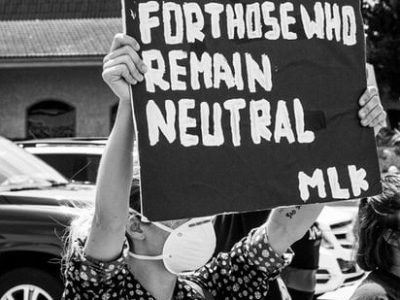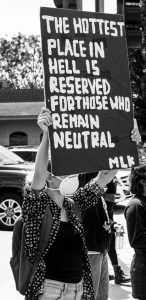

My favorite opening line from any Earth Day speech ever was this: “Today, black and white, yellow and brown, we are all green.” The speech was delivered three decades ago; the place was Times Square; and the speaker was David Dinkins, New York City’s first (and to date, only) African-American mayor. How I wish his words were, then or now, description rather than aspiration. That our common earth-saving cause created a bridge across chasms of race and class that threaten our long-term collective prospects on this marvel of a life-supporting planet in all its glorious inter- and intra-species diversity. And more immediately, that this shared planetary cause bridged the chasms that threaten our today-and-tomorrow-and-next-week prospects for coinhabiting our city streets and town squares and rural landscapes without rage, fear, or mutual suspicion.
With blood staining the sidewalks, carbon spewing unsustainably (still) into the atmosphere, and a pandemic spreading most virulently among the least advantaged, it seems fitting to connect the Great Green Project to inequality in America, and most specifically, to racial inequality. For as people of color frequently and helpfully remind: when race is staring us in the face and we talk about other things, we are choosing not to engage with it. As in elections, nonparticipation is a choice with consequences.
Let me provide one example—which is grounding in its specificity, and provides the requisite environmental law-and-policy hook—before looping back to the general condition it signifies. This week, in selecting among possible new client matters, our Environmental Law Clinic is choosing to position itself at the uncomfortable, high-friction interface between Traditional Environmentalists and Environmental Justice activists by taking on evaluation and critique of a celebrated climate change mitigation program known as Property Assessed Clean Energy (PACE). In brief, our working hypothesis, based on clients’ lived experiences (and subject to disproof if further data suggest otherwise), is that PACE is a great idea that has often gone badly wrong in implementation, because of inattention to equity.
The sensible premise of PACE is that the high up-front costs of installing alternative energy sources (such as rooftop solar), or efficiency improvements (like insulating a drafty attic), prevent broad-scale uptake of these available and necessary climate protection measures. PACE programs promise to solve this problem by initially providing green improvements to home or building owners for free. They then recoup the cost over time through increased property assessments. Taxpayers can afford these increases, the theory goes, because of cost savings from lower utility bills.
In practice, however, it has not always turned out so well. And specifically and overwhelmingly, it has not turned out well for many residential program participants at the socioeconomic bottom, who are—unsurprising—preferentially black and brown. Marketing and installation of home energy improvements in most jurisdictions’ PACE programs are left largely in the hands of poorly regulated for-profit home contractors. Predictably, abuses appear to be routine. For example, PACE improvements are often sold to elderly homeowners for whom the economics of energy upgrades could never pencil out even on paper (such as where an energy-sipping 80-year-old is sold a fancy rooftop PV system), or promised green improvements like insulation are so poorly installed (if indeed installed at all) that energy savings never materialize, even as tax bills rise. These math problems manifest for low-income homeowners as unpayable debt, underwater mortgages, and increasingly, home foreclosure.
To date, however, even minor attempts to curb PACE abuse in California through legislation have met intense political resistance and achieved at best partial success. The refreshingly bipartisan state consensus on our climate emergency (more on this below), coupled with insufficient empirical data on PACE abuse, has allowed an exhaustingly familiar narrative to prevail: PACE implementation problems in the hands of the home-contracting industry and the resulting victimization of people of color and the poor are—you guessed it—the fault of “a few bad apples.” Our Clinic looks forward to a deep data dive (into both statistics and PACE participants’ stories) that we expect will confirm our clients’ view: that PACE’s problems are pervasive and systemic. What happens thereafter is up to all of us.
Widening the lens: PACE—like so much in current climate discussions—forces us to consider, and ultimately choose between, competing moral claims. Traditional Environmentalists urge, correctly, that we must reduce greenhouse gases as fast as possible, and by all means available, to have any chance of planetary salvation. They further note, again fairly, that those at the socioeconomic bottom will benefit most from climate correction. It is the classic “a-rising-tide-lifts-all-boats” argument, bolstered by classically technocratic proposals.
Environmental Justice activists claim, in sharp contrast, that we will never have the broad societal buy-in necessary to scale climate solutions if we do not both include and shift power to those who have historically been excluded from energy decision-making (read: black and brown and poor people). And further, without a fundamental societal reordering in the direction of equity, we will not have disrupted the racism and wealth disparities that produce not only unfair, but universally bad energy policy. (It is here worth noting a nascent and, I hope, expanding literature on how environmental racism also hurts whites, such that, e.g., racially segregated areas have more air pollution in white neighborhoods than do well-integrated areas.)
What is a planet-concerned person of conscience to do? Schooled mostly but not wholly in Traditional Environmentalist ways of problem framing, in recent years—with the help of students, colleagues, and clients like those we will represent in our PACE reform project—I now subscribe strongly to the “All of Us or None” view held by Environmental Justice activists. Specifically: I vow, going forward, to abandon climate-first apologist narratives, under whose logic issues of race (and class, and other oppressions) can always be deferred for another day . . . meaning, the day when we have—fat chance on our current trajectory!—solar-celled and EV-ed and carbon-captured and energy-stored and geo-engineered our way below the 350 parts per million of atmospheric CO2 (or, whoops now, course correction, that number is already in the rear-view mirror. . . ) that we are told will permit us the luxury to engage with social justice. Predictably, that day remains perpetually on the next calendar page.
I therefore hope that in light of this week’s chilling events, all of us, whatever our environmental subfield, will commit to tithe some time to explore the anti-racism materials now widely web-available and even curated (this video provides a thoughtful perspective on recent riots; here is a wide-ranging anti-racist reading list; this book provides wise counsel for navigating issues of race in the classroom and beyond). And I hope we may all from there consider—in the privacy of our own homes (thank you, Covid?), our own heads, and most especially, our own hearts—how we might find some points of connection between racial inequities and our own domains of expertise.
We will make mistakes. And we should welcome correction, whether or not it comes where, when, and how we would prefer. The most potent, pernicious, and nonobvious aspect of white privilege, I have come too slowly to realize, is the permission it provides to choose not to engage. But now more than ever before, we are past the point where we can say of race that it is not “my issue.”
In the paragraph preceding her most famous line, poet Audre Lorde wrote that “community must not mean a shedding of our differences, nor the pathetic pretense that those differences do not exist.” Rather, says Lorde, our collective survival and well-being entails learning “how to make common cause with those others identified as outside the structures in order to define and seek a world in which we can all flourish.”
Simply put: It’s time—indeed long past time, good green friends— to show up for black lives.
The post Green in Black and White appeared first on Legal Planet.
By: Claudia Polsky
Title: Green in Black and White
Sourced From: legal-planet.org/2020/06/03/green-in-black-and-white/
Published Date: Wed, 03 Jun 2020 17:12:50 +0000
Vist Maida on Social Me
Website Links
Maida Law Firm - Auto Accident Attorneys of Houston, by fuseology
No comments:
Post a Comment